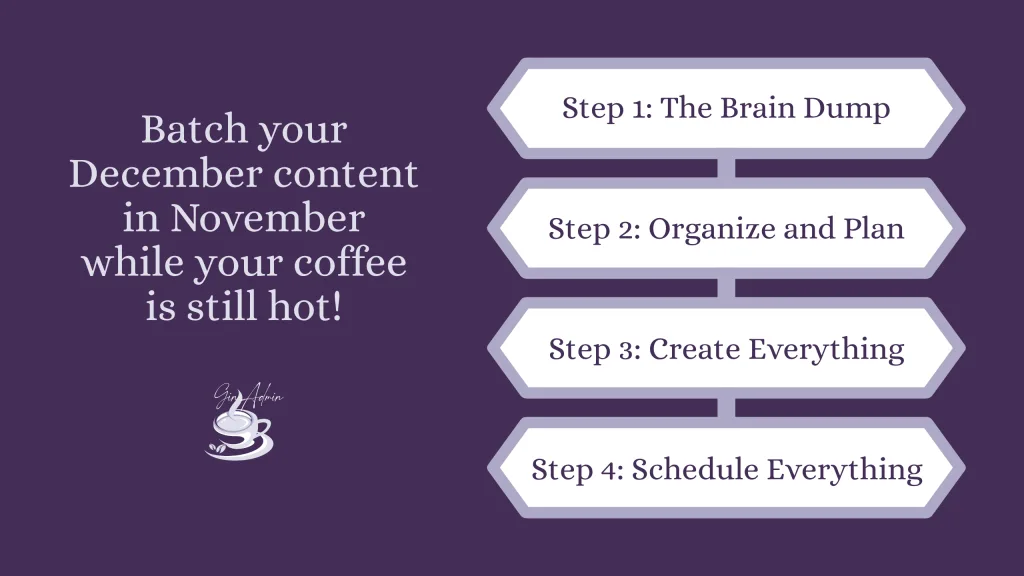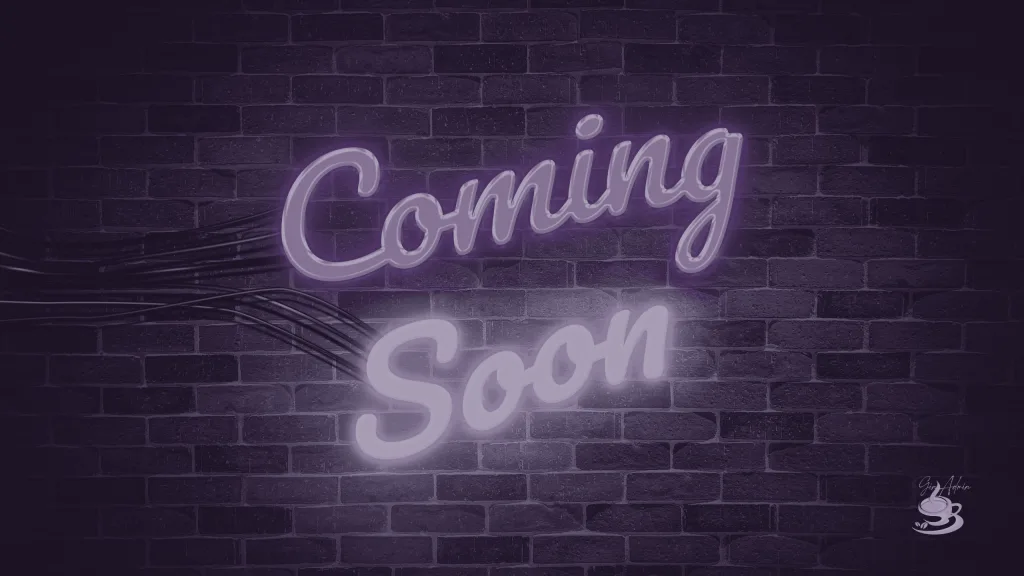November is completely different for small business owners.
Everyone else is planning Thanksgiving dinner and thinking about what pie to make.
Small business owners are supposed to be year-end planning, hitting revenue goals, planning for next year, creating holiday content, AND somehow finding time to buy actual gifts for actual humans.
It’s no wonder so many entrepreneurs hit December running on fumes and their fourth cup of coffee before 10am.
I spent years doing year-end planning wrong.
December would arrive and I’d suddenly realize I had no idea what happened in March.
Was that the month I launched that thing?
Or was that May?
And what were my goals again?
Then I’d panic-plan while eating leftover Halloween candy and pretending I had everything under control.
Hint: I did NOT have everything under control.
The shift happened when I moved my year-end planning to November.
Not December when I’m exhausted and distracted.
Not January when I’m trying to remember what I even did last year.
November.
Right now.
When I still have brain cells and the memories are fresh.
So let’s talk about how to wrap up this year without losing your mind, plus how to batch your entire December content calendar before your brain is too coffee-addled to form actual sentences.
The Year-End Planning Disaster
Imagine, if you will…
It’s December 28th and you’re sitting at your desk wearing yesterday’s sweatpants.
Someone somewhere said you should do a “year in review” but you can barely remember February.
Was that when you had all those new clients?
Or was that the month everything fell apart and you literally lived on coffee and stress?
Your December content strategy consisted of panic-posting whatever popped into your head between customer orders and family obligations.
Now you’re supposed to analyze the entire year, set goals for next year, AND enjoy the holidays?
This is why waiting until December doesn’t work.
When you put off your year-end planning, you end up with half-done reviews, vague goals like “make more money,” and zero holiday content because you were too busy surviving.
The small business owners who start January feeling prepared?
They did this work in November.
Why November Changes Everything
November gives you something December can’t: breathing room.
You’re past the Q3 chaos but not yet drowning in holiday madness.
Your brain still functions.
You can think strategically instead of just putting out fires.
I’m writing this on my second coffee of the morning, looking at my November calendar.
It’s full but pretty manageable.
Come December?
That calendar looks like someone threw every possible commitment at a wall and they all stuck.

So we do the hard thinking now, while we can.
This month, look back at this year while the memories are fresh but the pressure is manageable.
Batch your December content so future-you isn’t scrambling.
Set yourself up for a January that starts with momentum instead of confusion.
Use November wisely and you glide into the new year feeling prepared.
Waste it and you stumble into January wondering where the last two months went and why you’re already behind.
The 90-Minute Year-End Review That Actually Works
I’m not asking you to do some complicated business audit that requires spreadsheets and a finance degree.
This is way simpler than that.
Grab your favorite coffee mug, find a quiet spot, and set a timer for 90 minutes.
That’s all this takes.
The Honest Look Back (30 Minutes)
Open your notebook (or your laptop if you’re fancy) and answer these questions without overthinking.
What worked really well this year? Not what you think you should say, but what actually moved the needle. Maybe that Instagram strategy everyone said was dead actually brought you clients. Maybe your email list grew when you finally started being yourself instead of trying to sound “professional.”
Did you have something that completely flopped? Every business has things that didn’t work. Write them down so you stop wasting energy on them next year. I spent three months on a content strategy that got zero engagement because I was copying what worked for someone else’s audience. Learning what not to do is just as valuable as learning what works.
What surprised you? Sometimes the best opportunities come from unexpected places. A casual LinkedIn post that went viral. A service you offered as an experiment that people actually wanted. Pay attention to these surprises.
Is there a service (or a client…) that completely drained your energy? This matters more than most people realize. Maybe a service made decent money but left you exhausted every time. That’s information worth having.
What made you happy? Because building a business that makes you miserable defeats the entire purpose of entrepreneurship.
Your first instincts are usually right, so don’t second-guess yourself.
This isn’t about perfection.
It’s about gaining clarity.
The Numbers Reality Check (20 Minutes)
Now let’s look at what actually happened with money.
Pull up your revenue for the year.
How did you do compared to your goals? If you missed them, why? If you exceeded them, how?
Check your expenses. Any surprises lurking in there? Any categories that grew more than you expected?
I once discovered I was spending $300 a month on software subscriptions I forgot I had. That’s $3,600 worth of coffee I could have bought instead!!
Look at profit margins, not just revenue. Making a lot of money means nothing if you’re spending almost all of it. Are you actually profitable or just busy?
Review which products or services made you the most money with the least stress. Sometimes your cash cow isn’t what you think it is.
This doesn’t need to be complicated.
You’re gathering data to structure your next year’s planning (we’ll tackle that in the next blog post).

The Client and Customer Review (15 Minutes)
Who were your favorite people to work with this year?
I keep a running list of clients who energize me versus clients who drain me. Both groups pay the same, but one makes me excited to work and the other makes me fantasize about deleting my email.
What patterns do you notice about your best customers? Mine tend to find me through referrals, they’ve been in business at least two years, and they actually implement what I suggest instead of arguing about it.
Which clients weren’t worth the revenue they brought in? Sometimes you need to fire clients to save your sanity.
What feedback did you consistently hear? If three people ask for the same thing, that’s probably something worth offering.
This information becomes your targeting strategy for the new year.
You know exactly who you want more of and what they need from you.
The Content and Marketing Audit (25 Minutes)
Pour yourself a fresh cup of coffee for this part because it might sting a little.
What content performed best this year? Not what you HOPED would perform, but what actually got engagement, shares, saves, or conversions.
Which marketing channels brought in real leads or sales? I wasted months on Pinterest because someone told me it was “the future” only to discover that my audience doesn’t actually use Pinterest. Meanwhile, LinkedIn was quietly bringing me qualified leads.
Don’t get me wrong. I LOVE Pinterest. But that is NOT where MY audience is!
What did you spend time on that didn’t move the needle? We all have content or strategies that sounded good in theory but did absolutely nothing in practice.
Where did your audience actually engage? Sometimes they’re hanging out somewhere that you’re barely posting, while you’re putting effort into a platform where nobody cares (see Pinterest reference above).
This audit helps you see clearly what to double down on and what to abandon.
Stop doing things because you think you should.
Start doing things because they actually work for your specific business.
Batching December Content Before You’re Too Tired to Think
December will be chaos no matter what you do.
Family obligations, holiday orders, year-end deadlines, plus the general madness of trying to be festive while also running a business.
Your brain will be mush.
Which is exactly why you can’t wait until December to create December content.
I learned this the hard way after spending three Decembers in a row panic-posting whatever I could think of at 11 PM while eating cookies for dinner.
The content was terrible.
I was exhausted.
And I spent the whole month feeling behind.
Now I batch my December content in November while I still have functioning brain cells.

Step 1: The Brain Dump
Set a timer for 15 minutes and dump every content idea for December into a document.
Holiday tips for your audience. Year-end reflection posts. Gratitude content about customers or clients. Behind-the-scenes of your holiday prep. Product or service features that solve holiday problems. Teasers for what’s coming in the new year.
Don’t edit yourself during the brain dump. Just get it all out. You’ll organize it later.
Step 2: Organize and Plan
Look at your brain dump and sort content into the four weeks of December.
- Week one of December might focus on gratitude and year-end reflection.
- Week two could highlight your offerings for last-minute holiday needs.
- Week three wraps up the year with lessons learned.
- Week four looks forward to next year.
You’re not planning every single post.
You’re creating a framework that makes content creation easier.
Keep it realistic.
If posting five times a week isn’t sustainable, don’t plan for it.
Three solid posts beat five mediocre ones.
Step 3: Create Everything
Block out 2-3 hours on your calendar and create all your December content in one or two focused sessions.
Write the captions. Design the graphics. Record the videos.
Do it all now while you still have mental clarity.
I usually do this on a Saturday morning with a big mug of coffee and my favorite playlist.
No distractions, no client work, just content creation.
Use AI tools for first drafts or headline variations if that helps, but make sure everything sounds like you.
Nobody wants to read generic AI-speak about “leveraging holiday synergies” or whatever nonsense it comes up with.
Step 4: Schedule Everything
Load your content into whatever scheduling tool you use.
When December hits, your content is handled.
You show up, engage with comments, and actually enjoy the holidays instead of stressing about what to post.
This system works because you’re not trying to be creative while exhausted.
You’re creating from a place of energy in November, then coasting through December on autopilot.
What to Actually Post in December
Gratitude posts perform well because people are already in that mindset. Thank your clients , highlight team members, share what you’re grateful for in your business.
Year-in-review content gives people a peek behind the curtain. Share your business highlights, lessons learned, favorite moments. Be real about the hard parts too.
Behind-the-scenes content during the busy season helps people feel connected. Show what December looks like in your business. The coffee-fueled mornings, the organized chaos, the late nights.
Customer spotlights celebrate the people who made your year possible. Feature clients or customers and why you love working with them.
Product or service features solve actual holiday problems. Don’t just push sales. Help people.
Teasers for next year get people excited about what’s coming. Give them something to look forward to.

Holiday tips relevant to your expertise provide value when people need it most.
Mix these throughout December and your content calendar feels natural instead of forced.
Setting Yourself Up for the new year
Everything you learned from this year-end review becomes the foundation for your next year’s strategy.
You’re not starting from scratch in January trying to remember what happened.
You have fresh data, clear patterns, and honest assessments that make planning your next year so much easier.
In my next blog post, we’ll take everything you learned here and turn it into a solid strategy, complete with content planning for the entire year and realistic goals that don’t require working 80-hour weeks.
But first, you need to do this November work.
Review your year. Batch your December content. Set yourself up to finish the year strong.
Your November Action Plan
This week, do your honest look-back session and run your numbers reality check.
Also start your December content brain dump.
Complete your client review and content audit.
Organize your December content by week.
Batch create all your December content.
Review your findings from the year.
Schedule all your December content and tie up loose ends.
Then read my next strategy blog post to plan what’s ahead.
The goal isn’t perfection.
The goal is finishing the year with clarity about what happened and December content that’s already handled.
Small business owners who take time to do year-end planning properly hit the ground running in January.
The ones who batch December content in November actually enjoy eggnog instead of stress-posting at midnight.
Which one sounds better?
One November planning session changes how you finish this year and start the next one.
Your new year’s strategy will be easier because you did this foundational work.
Now grab that coffee, block out the time, and let’s wrap up this year the right way.
Your small business deserves a better year ending than scrambling through December wondering where the year went.
You deserve to actually enjoy the holidays instead of working through them fueled by stress and caffeine.
November is your chance to make that happen.
You’ve got this!
Need accountability to actually finish your year-end planning? Grab my Fix My Content Checklist and use it alongside your year-end planning. Because if your content strategy isn’t working, no amount of year-end planning will fix it. Might as well tackle both now while you still have brain cells left.




